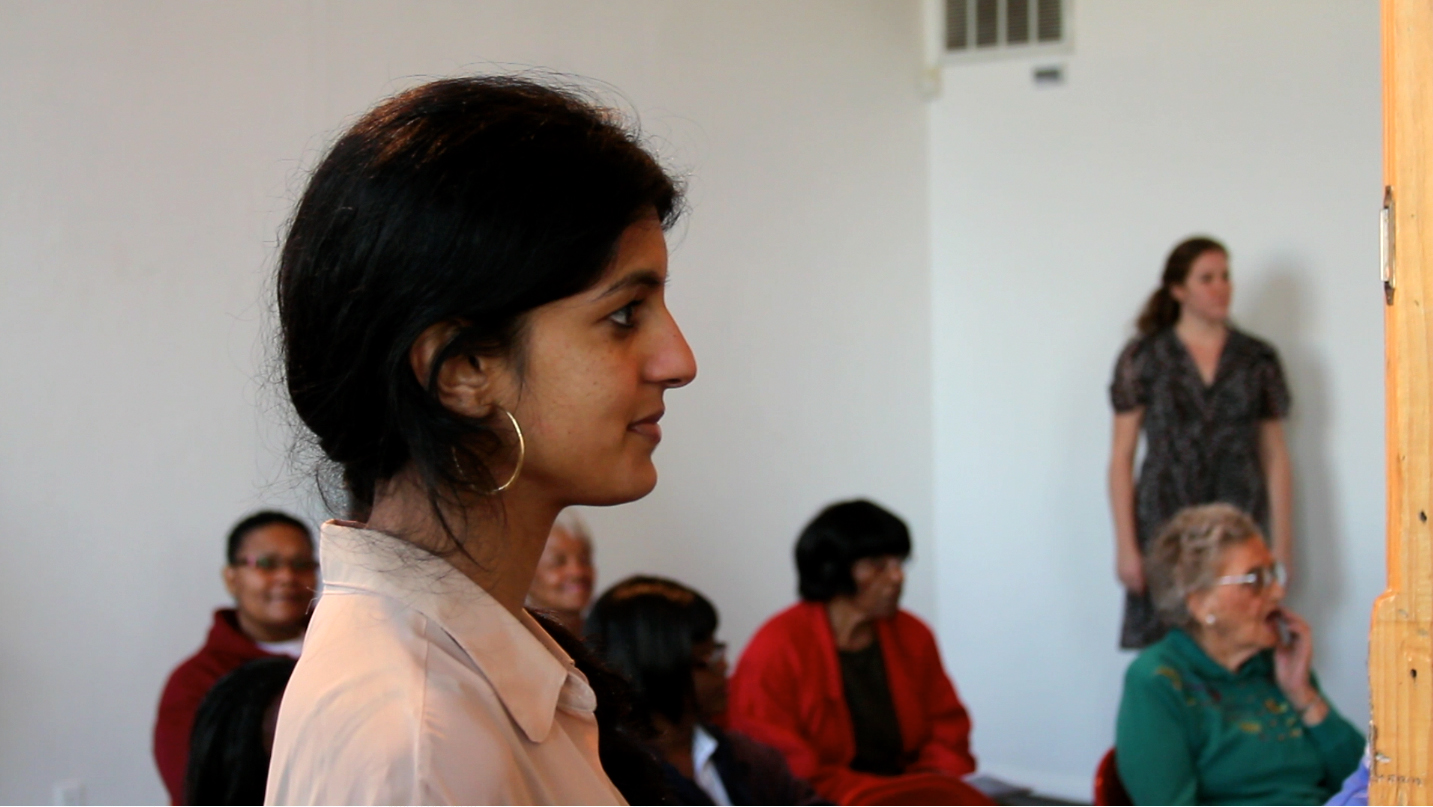January 28, 2012
[audio:http://colemanarts.org/wp/wp-content/uploads/2012/02/WeAreMany.mp3|titles=We Are Many] [Click above for audio of the complete performance]
The Coleman Center for the Arts (CCA) is pleased to present the Community Coalition Choir performing it’s debut piece, We Are Many, by Samita Sinha. Choir members John Brown, Shana Berger, Daymekia Carter, Jocelyn Edens, James Goodwin, Judy Massey, Kanita Sturdivant, Samita Sinha, Jahlliyah Watkins and LaTeasha Watkins blend varied musical traditions including old songs from Sumter County, modern gospel, traditional sacred songs, new youth texts, classical Indian music and choral experiments.
The work is the culmination of Samita Sinha’s two year relationship with the CCA and the Sumter County community. In five trips over the last 18 months the artist has focussed on musical exchanges throughout Sumter County. In May of 2010 working with collaborator Stephanie Loveless, Sinha offered a Community Sing, based on the work of late artist Sekou Sundiata. Through the process of singing collectively, talking, singing again with deeper awareness, and talking more deeply, the group identified and discussed ideas of personal and cultural faith, transformation, music and citizenship.
Sinha remarks, “I had never heard such musical excellence in community workshops as I experienced here in York. Folks here could sing, in tune and with spontaneous harmonies, and the voices came directly from the heart.” In following visits, Sinha and community members shared sacred and personal songs that make up our (musical) identities. That experience paved the way for the Community Coalition Choir (CCC), which creates a space for exchange and a shared experience with social, political and spiritual implications.
We Are Many consists of eight pieces sung in a continuous set. In the opening piece, Done / One Tone, the choir becomes a human tanpura, a four-stringed Indian instrument that creates a constant drone. The drone serves as the foundation for melodic improvisation in Indian music. The human drone allows the performers and the audience to focus, relax, tune into to one another and hear each unique voice.
The rendition of What is the Soul of Man is Inspired by the 1939 recording of Vera Ward Hall and Doc Reed, made by Alan Lomax and Ruby Pickens Tart in Livingston, Alabama. Additional verses were written by CCA students LaTeasha Watkins and James Goodwin. Sinha has studied these songs for a number of years, through the Alan Lomax archive. While listened to the world over, many of the old songs native to Sumter County are no longer sung or even known here. The path of the recordings over cultures, geography and time weave a complex narrative about identity and belonging central to the CCC.
Sinha and her lead collaborators all contributed a song from their own professional singing practices. In Paavat Kaun, which translates to “how can we get to the other side?” Sinha leads the group in an a traditional composition in the Indian Raga Bhimpalasi. It is arranged in a call and response style inspired by Baptist singing traditions. Kanita Sturdivant offered the song I Pray We’ll All Be Ready, a contemporary gospel song by Marlowe Cribb that is a frequent part of the repertoire at Truevine Fellowship Church in York. John Brown contributed the traditional Jewish song Hevenu Shalom Aleichem which translates to “we bring peace unto you.”
The Slow Sing is a choral experiment inspired by the work of Pauline Oliveros. In the We are Many iteration each singer performs a song of their own that reminds them of home. Everyone sings at the same time, singing slowly four notes per breath. Never the same twice, the performance sustains both unity and dissonance through different notes and common breath, producing waves of harmony and crescendo.
The set concludes with two pieces accompanied by the human drone. In Two Kinds of Blues Sinha weaves a thumri, Indian classical “blues,” with Sturdivant’s performance of Vera Ward Hall’s Poor Lazarus. The CCC rendition of Amazing Grace then combines different ways of singing the classic spiritual. In the last verse the audience is invited to join the choir, concluding the piece with collective participation that characterized Sinha’s work throughout her visits.
The texts that make up We Are Many could not have existed together outside of this new context. We Are Many surpasses the concept of an “iPod generation” that concurrently listens to disparate forms of music, together but not united. The work results from personal connections and the contemporary mitigation of geographic, temporal, and cultural boundaries. An ethos of the Community Coalition Choir might say I’ll sing your song and I know you will sing mine. We can all sing our songs together, individually or at at once. We are a complex plurality. Together we create new expressions for our individual and collective identities.
This project is made possible by support from the Andy Warhol Foundation for the Visual Arts, the America Project of MAPP International Productions, the Alabama State Council on the Arts, and the National Endowment for the Arts.
Samita Sinha
Trained in classical Hindustani vocal music, composer/ performer Samita Sinha uses the range of her voice together with electronics and multilingual text in solo performance and multichannel vocal pieces. Besides her solo work, Sinha has a duo project with Marc Cary called ANATOMY (electronic/ Hindustani/ jazz), uses her voice as an improvising instrument in jazz ensembles (in Marc CaryÕs FOCUS Trio, Sunny Jain Collective, and Eternal Now), and has toured internationally as a vocalist with the late performance poet Sekou SundiataÕs the 51st (dream) state.

